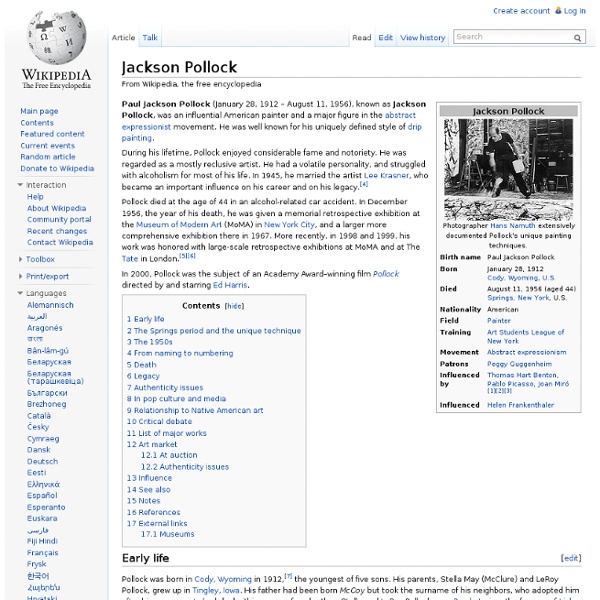Edward Hopper
Edward Hopper (July 22, 1882 – May 15, 1967) was a prominent American realist painter and printmaker. While he was most popularly known for his oil paintings, he was equally proficient as a watercolorist and printmaker in etching. Both in his urban and rural scenes, his spare and finely calculated renderings reflected his personal vision of modern American life.[1] Biography[edit] Early life[edit] Childhood home of Edward Hopper in Nyack, New York Hopper was born in upper Nyack, New York, a yacht-building center on the Hudson River north of New York City.[2] He was one of two children of a comfortably well-off, middle-class family. Hopper was a good student in grade school and showed talent in drawing at age five. In his early self-portraits, Hopper tended to represent himself as skinny, ungraceful, and homely. Hopper began art studies with a correspondence course in 1899. Another of his teachers, artist Robert Henri, taught life class. Years of struggle[edit] Summer Interior (1909)
Boardwalk Empire
Boardwalk Empire is an American period drama series from premium cable channel HBO, set in Atlantic City, New Jersey, during the Prohibition era. It stars Steve Buscemi as Nucky Thompson. Primetime Emmy Award-winning screenwriter and producer Terence Winter created the show inspired by the book Boardwalk Empire: The Birth, High Times, and Corruption of Atlantic City by Nelson Johnson about historical criminal kingpin Enoch L. Johnson.[2] Boardwalk Empire has received widespread critical acclaim, particularly for its visual style and basis on historical figures, as well as for Buscemi's lead performance.[8] The series has received forty Primetime Emmy Award nominations, including two for Outstanding Drama Series, winning seventeen. Series overview[edit] Boardwalk Empire is a period drama focusing on Enoch "Nucky" Thompson (based on the historical Enoch L. Season 1 (2010)[edit] Season 2 (2011)[edit] Season 3 (2012)[edit] Season 4 (2013)[edit] Cast and characters[edit] Main cast[edit] Crew[edit]
performa-arts
The Drawing Center | Exhibitions-Current | New York, NY
Rebecca Horn - official website
Rebecca Horn 1944 Born 1963 Studies at the Hochschule für Bildende Künste, Hamburg 1971 DAAD-scholarship at Saint Martins College of Art, London 1972–1981 Lives in New York 1974 Teaches at the California Art Institute, University of San Diego 1975 Deutscher Kritikerpreis (German Critic’s Award) for her film Berlin – Exercises in nine parts: Dreaming under water of things afar 1977 Awarded the ‘Kunstpreis der Glockengasse’, Cologne 1979 Awarded the ‘Kunstpreis der Böttcherstraße’, Bremen 1986 Awarded the ‘documenta-Preis’, Kassel 1988 Awarded the Carnegie Prize at Carnegie International, Pittsburgh, for The Hydra Forest, Performing Oscar Wilde 1989 Begins teaching at the Hochschule der Künste, Berlin 1992 Awarded the ‘Kaiserring der Stadt Goslar’ and the ‘Medienkunstpreis Karlsruhe’ 2004 Awarded the Barnett and Annalee Newman Award, New York 2005 Awarded the ‘Hans-Molfenter-Preis’, Stuttgart 2006 Awarded the ‘Piepenbrock Preis für Skulptur’, Berlin 2009 Alice Salomon Poetik Preis, Berlin top 9. WACK!
Olafur Eliasson
Piet Mondrian
Pieter Cornelis "Piet" Mondriaan, after 1906 Mondrian (/ˈmɔːndriˌɑːn, ˈmɒn-/;[1] Dutch: [ˈpit ˈmɔndrijaːn], later [ˈmɔndrijɑn]; 7 March 1872 – 1 February 1944), was a Dutch painter. Mondrian's arrival in Paris from the Netherlands in 1911 marked the beginning of a period of profound change. He encountered experiments in Cubism and with the intent of integrating himself within the Parisian avant-garde removed an 'a' from the Dutch spelling of his name (Mondriaan).[3][4] The Netherlands (1872–1911)[edit] In this house, now the Villa Mondriaan, in Winterswijk, Piet Mondrian lived from 1880 to 1892 Mondrian was born in Amersfoort in the Netherlands, the second of his parents' children.[5] He was descended from Christian Dirkzoon Monderyan who lived in The Hague as early as 1670.[3] The family moved to Winterswijk in the east of the country when his father, Pieter Cornelius Mondriaan, was appointed Head Teacher at a local primary school.[6] Mondrian was introduced to art from a very early age.
Jean-Paul Sartre
Un article de Wikipédia, l'encyclopédie libre. Œuvres principales Compléments Jean-Paul Sartre, né le dans le 16e arrondissement de Paris et mort le dans le 14e arrondissement[1], est un écrivain et philosophe français, représentant du courant existentialiste, dont l'œuvre et la personnalité ont marqué la vie intellectuelle et politique de la France de 1945 à la fin des années 1970. Intransigeant et fidèle à ses idées, il a toujours rejeté les honneurs ; il a notamment refusé le prix Nobel de littérature en 1964 ; exception notable, il a cependant accepté le titre de docteur honoris causa de l'Université de Jérusalem en 1976. Sa relation particulière avec Simone de Beauvoir est un autre élément de sa notoriété. Biographie[modifier | modifier le code] « Je n’essaie pas de protéger ma vie après coup par ma philosophie, ce qui est batard, ni de conformer ma vie à ma philosophie, ce qui est pédantesque, mais vraiment, vie et philo ne font plus qu’un. » Carnets de la drôle de guerre — Sartre autres



